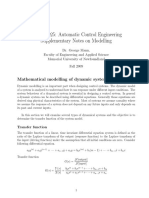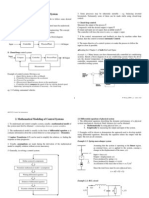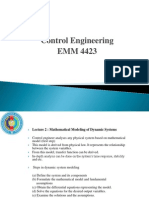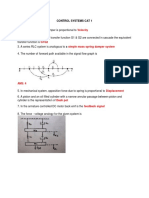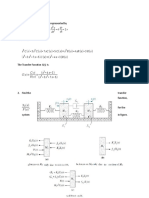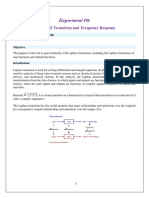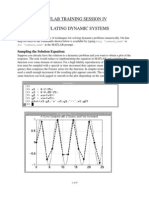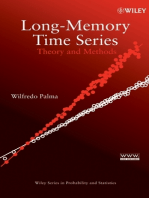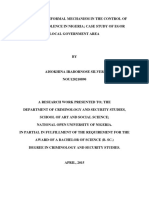Me 360 Transfer Functions
Uploaded by
ftoomauaeMe 360 Transfer Functions
Uploaded by
ftoomauaeME 360 Control Systems Transfer Functions
Single-Input, Single-Output (SISO) Systems o For linear systems that have a single input and a single output, we can define a single transfer function that quantifies the dynamic behavior of the system. o Mathematically, the transfer function is defined as the Laplace transform of the output divided by the Laplace transform of the input, assuming all initial values are zero. o As an example, consider the single degree-of-freedom mass, spring, damper system shown with a forcing function f (t ) . For this system, we know that the differential equation of motion is
mx + bx + kx = f (t )
o Applying Laplace transforms to both sides of the equation and assuming that all initial values are zero, we get
f (t )
x
(ms 2 + bs + k ) X ( s ) = F ( s ) Given that the input is f (t ) and the output is x(t ) , the system transfer function is defined to be
X (s) 1 = 2 F ( s ) ms + bs + k
o If the base motion y (t ) is the system input, then the differential equation of motion is
mx + bx + kx = by + ky
x
o Applying Laplace transforms to this equation gives
(ms 2 + bs + k ) X ( s ) = (bs + k )Y ( s ) Given the input is y (t ) and the output is x(t ) , the system transfer function is
X (s) bs + k = 2 Y ( s ) ms + bs + k
k
y (t )
o If the input to the system is the impulse function, (t ) , then X ( s ) the Laplace transform of the response is equal the transfer function, since F ( s) = L( (t )) = 1 . So, the transfer function describes the impulse response of the system. o In general, a transfer function will have the form
X ( s ) s m + bm s m1 + bm1s m2 + + b1 = F ( s ) s n + an s n1 + an1s n2 + + a1
o The roots of the numerator are called the zeros of the system, and the roots of the denominator are called the poles of the system. In this class, we will assume that the order of the numerator is less than the order of the denominator, that is, m < n .
Multiple-Input, Multiple-Output (MIMO) Systems
o For linear systems with M input variables and N output variables, we define M N transfer functions, one relating each input/output pair. Together, these transfer functions can be used to quantify the behavior of the system. As before, the transfer function is defined as the Laplace transform of the output variable divided by the Laplace transform of the input variable, assuming all initial values are zero. o As an example, consider the two degree-of-freedom mass, spring system shown with forcing functions f1 (t ) and f 2 (t ) . It can be shown that the equations of motion for this system may be written as
m1 x1 + (k1 + k2 ) x1 k2 x2 = f1 (t ) m2 x2 k2 x1 + k2 x2 = f 2 (t )
o Applying Laplace transforms to these equations and writing the resulting equations in matrix form gives
m1s 2 + k1 + k2 k2
X 1 ( s) F1 ( s ) = [ A]{ X ( s )} = = { F ( s )} F2 ( s ) m2 s 2 + k2 X 2 ( s ) k2
o From this equation, we define four transfer functions. Note that for the transfer functions involving F1 ( s ) , we assume F2 ( s ) = 0 , and for the transfer functions involving F2 ( s ) , we assume F1 ( s ) = 0 .
X 1 ( s) X 1 ( s) X 2 ( s) X ( s) , , , and 2 . F1 ( s ) F2 ( s ) F1 ( s ) F2 ( s )
2
o Using Cramer's Rule we can solve the boxed equation above for X 1 ( s ) and X 2 ( s ) :
k2 F (s) det 1 2 F2 ( s ) m2 s + k2 X 1 ( s) = det[ A] m s 2 + k2 k2 F2 ( s ) = 2 F1 ( s ) + det[ A] det[ A] where det[ A] = (m1s 2 + k1 + k2 )(m2 s 2 + k2 ) k22 .
m1s 2 + k1 + k2 det k2 X 2 ( s) = det[ A] F1 ( s ) F2 ( s )
m1s 2 + k1 + k2 k2 = F2 ( s ) F1 ( s ) + det[ A] det[ A]
o From these results we can now define the four transfer functions of the system.
X 1 ( s ) m2 s 2 + k2 = F1 ( s ) det[ A]
X 2 ( s ) k2 = F1 ( s ) det[ A]
X 1 ( s ) k2 = F2 ( s ) det[ A]
X 2 ( s ) m1s 2 + k1 + k2 = F2 ( s ) det[ A]
Experimental Determination of Transfer Functions
o To measure transfer functions experimentally, we use actuators to excite the system, sensors to measure the system input and response (output), and a data acquisition system to record the signals. o MATLABs system identification toolbox uses these signals to estimate the transfer function that relates the two. o A dynamic signal analyzer can also be used. In addition to recording the system input and output signals, it can calculate their Fast Fourier Transforms (FFT's) and display the ratio (output/input) in the form of a Bode diagram. The Bode diagram is one way of graphically displaying a transfer function. We will discuss Bode diagrams later in the semester.
3
You might also like
- Hourglass Workout Program by Luisagiuliet 276% (21)Hourglass Workout Program by Luisagiuliet 251 pages
- The Hold Me Tight Workbook - Dr. Sue Johnson100% (16)The Hold Me Tight Workbook - Dr. Sue Johnson187 pages
- Read People Like A Book by Patrick King-Edited62% (65)Read People Like A Book by Patrick King-Edited12 pages
- Livingood, Blake - Livingood Daily Your 21-Day Guide To Experience Real Health77% (13)Livingood, Blake - Livingood Daily Your 21-Day Guide To Experience Real Health260 pages
- COSMIC CONSCIOUSNESS OF HUMANITY - PROBLEMS OF NEW COSMOGONY (V.P.Kaznacheev,. Л. V. Trofimov.)94% (212)COSMIC CONSCIOUSNESS OF HUMANITY - PROBLEMS OF NEW COSMOGONY (V.P.Kaznacheev,. Л. V. Trofimov.)212 pages
- Donald Trump & Jeffrey Epstein Rape Lawsuit and Affidavits83% (1016)Donald Trump & Jeffrey Epstein Rape Lawsuit and Affidavits13 pages
- The 36 Questions That Lead To Love - The New York Times94% (34)The 36 Questions That Lead To Love - The New York Times3 pages
- The 36 Questions That Lead To Love - The New York Times95% (21)The 36 Questions That Lead To Love - The New York Times3 pages
- Jeffrey Epstein39s Little Black Book Unredacted PDF75% (12)Jeffrey Epstein39s Little Black Book Unredacted PDF95 pages
- The 4 Hour Workweek, Expanded and Updated by Timothy Ferriss - Excerpt23% (954)The 4 Hour Workweek, Expanded and Updated by Timothy Ferriss - Excerpt38 pages
- Translation Mechanical System Transfer FunctionNo ratings yetTranslation Mechanical System Transfer Function28 pages
- ENGR 6925: Automatic Control Engineering Supplementary Notes On ModellingNo ratings yetENGR 6925: Automatic Control Engineering Supplementary Notes On Modelling31 pages
- Handout E.15 - Examples On Transient Response of First and Second Order Systems, System Damping and Natural FrequencyNo ratings yetHandout E.15 - Examples On Transient Response of First and Second Order Systems, System Damping and Natural Frequency14 pages
- 1-01-c Transfer Function and System Block DiagramNo ratings yet1-01-c Transfer Function and System Block Diagram14 pages
- Mathematical Modeling of Mechanical Systems and Electrical SystemsNo ratings yetMathematical Modeling of Mechanical Systems and Electrical Systems49 pages
- Identification: 2.1 Identification of Transfer Functions 2.1.1 Review of Transfer FunctionNo ratings yetIdentification: 2.1 Identification of Transfer Functions 2.1.1 Review of Transfer Function29 pages
- Transfer Functions and Block Diagrams PDFNo ratings yetTransfer Functions and Block Diagrams PDF21 pages
- Modeling in The Frequency Domain: Prof. Ju-Jang LeeNo ratings yetModeling in The Frequency Domain: Prof. Ju-Jang Lee32 pages
- System Dynamics and Control (ME422 - 03 - Spring - 2017) : Instructor: Prof. Ayman A. Aly El-NaggarNo ratings yetSystem Dynamics and Control (ME422 - 03 - Spring - 2017) : Instructor: Prof. Ayman A. Aly El-Naggar44 pages
- Lesson No. 4 Transfer Functions, Poles and ZerosNo ratings yetLesson No. 4 Transfer Functions, Poles and Zeros18 pages
- Chapter-1: 1.1 Control Design ProcedureNo ratings yetChapter-1: 1.1 Control Design Procedure23 pages
- Experiment - 2 2.1 Multi - Block Systems:: Clear CLCNo ratings yetExperiment - 2 2.1 Multi - Block Systems:: Clear CLC13 pages
- Obtaining State-Space Model From Transfer Function or Vice VercaNo ratings yetObtaining State-Space Model From Transfer Function or Vice Verca28 pages
- Mathematical Madeling and Block DiagramaaNo ratings yetMathematical Madeling and Block Diagramaa93 pages
- 01 Automatic Control System Modeling and RepresentationNo ratings yet01 Automatic Control System Modeling and Representation55 pages
- Chapter 3 Mathematical Modeling of Dynamic SystemsNo ratings yetChapter 3 Mathematical Modeling of Dynamic Systems28 pages
- Laplace, Z Transform and Frequency Response: Experiment 10No ratings yetLaplace, Z Transform and Frequency Response: Experiment 107 pages
- Matlab Training Session Iv Simulating Dynamic Systems: Sampling The Solution EquationNo ratings yetMatlab Training Session Iv Simulating Dynamic Systems: Sampling The Solution Equation9 pages
- Control System Fundamental: Time Response Analysis100% (1)Control System Fundamental: Time Response Analysis77 pages
- System Identification Using Laguerre Functions: Simple ExamplesNo ratings yetSystem Identification Using Laguerre Functions: Simple Examples6 pages
- Design of Controller For Buck Boost ConverterNo ratings yetDesign of Controller For Buck Boost Converter5 pages
- Student Solutions Manual to Accompany Economic Dynamics in Discrete Time, secondeditionFrom EverandStudent Solutions Manual to Accompany Economic Dynamics in Discrete Time, secondedition4.5/5 (2)
- Nonlinear Control Feedback Linearization Sliding Mode ControlFrom EverandNonlinear Control Feedback Linearization Sliding Mode ControlNo ratings yet
- Module Title: Mechanical Materials (3D) : MECH8012No ratings yetModule Title: Mechanical Materials (3D) : MECH80124 pages
- How To Make DIFFICULT Choices by Gaur Gopal DasNo ratings yetHow To Make DIFFICULT Choices by Gaur Gopal Das4 pages
- Profile 8M DC: Optibelt DELTA CHAIN Carbon 896 8MDC 21No ratings yetProfile 8M DC: Optibelt DELTA CHAIN Carbon 896 8MDC 211 page
- ADM 4615 & MBA 6623 - Fall 2018 H.W. #1No ratings yetADM 4615 & MBA 6623 - Fall 2018 H.W. #111 pages
- The Role of Informal Mechanism in The CoNo ratings yetThe Role of Informal Mechanism in The Co28 pages
- Political Science MCQs With Explanation For CSS (Machiavelli)100% (1)Political Science MCQs With Explanation For CSS (Machiavelli)3 pages
- How To Set Up Reports in The Page LayoutNo ratings yetHow To Set Up Reports in The Page Layout2 pages
- 4-5. Art, Copy - Creative Strategy-Ganjil2021-2022No ratings yet4-5. Art, Copy - Creative Strategy-Ganjil2021-2022163 pages
- Post Weld Heat Treatment Procedure: Doc Ref: Isb/Pwht100% (4)Post Weld Heat Treatment Procedure: Doc Ref: Isb/Pwht13 pages
































